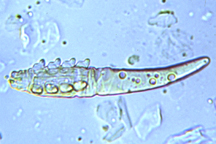UF/IFAS News Release
 | 04.23.2003 It's Enough To Make Your Skin Crawl: Microscopic Mites May Be Linked To Acne, Thinning Hair And Other Skin Disorders
|
|
GAINESVILLE, Fla.--- Youíre not alone. Most people have thousands —probably millions — of tiny bugs called mites living in their hair and on their skin. And now a University of Florida researcher says the microscopic mites may be linked to thinning hair, acne and other skin conditions.
Many people donít like the idea of bugs living in their hair or on their skin, and some get really bent out of shape just thinking about it," said Jerry Butler, a professor of entomology with UFís Institute of Food and Agricultural Sciences. For some folks, itís enough to make your skin crawl. And bathing wonít wash them off." Known as the Demodex mite, the bug lives in the hair follicles of 96 percent to 98 percent of all people and feeds on oils, hormones and fluids around the follicle. Butler has counted as many as 25 mites in a single hair follicle. In his UF entomology class, Butler lets students examine oily samples from their own skin pores to learn how well the mites are thriving on their bodies. For most people, the itty-bitty bugs are harmless and live in balance with their human host, he said. Most people and animals have a tolerance for the mites without developing any skin conditions, but high populations can cause problems. "When something causes the mites to reproduce at a higher rate, they can break out of the hair follicle and may cause acne, hair loss and other skin conditions," Butler said. "In some cases, the interaction with mites causes skin to actually slough off." He said studies have shown the mini-mite is associated with many kinds of skin conditions, but most researchers are reluctant to conclude itís a direct cause of those skin conditions. While Demodex may cause certain problems, itís also possible certain skin conditions become a breeding ground for mites. Dr. Frank Flowers, a professor of dermatology at UFís Health Science Center, said, There is a tenuous link between Demodex, acne rosacea and folliculitis. However, no skin disease in humans has been conclusively linked with these mites." Flowers said that one of the most effective treatments for these disorders is metronidazole cream. Butler, a veterinary medical entomologist who has studied mites on dogs, said people probably react to large numbers of mites in the same way as our canine friends. Based on my experience with dogs, particularly young animals whose hormone and immune systems are not fully developed, you probably get similar results on people," he said. Populations can explode on dogs, causing mange-like symptoms. "The link between mites and hair loss and other skin conditions is not conclusive, but we do know itís a major problem for dogs," Butler said. "If you have high levels of hormones, youíre going to have high levels of mite reproduction because these anthropods obtain their steroids from the host." Butler said Demodex poses the biggest threat to people under stress or those with cancer or other conditions such as HIV/AIDS that suppress the immune system. Mite colonies can spread unchecked because patients cannot produce the antibodies needed to control the parasites. "Under normal conditions, mites produce an antigen when they feed in a hair follicle, and then the human body makes antibodies against the bugs, thereby keeping their reproduction low and in balance," Butler said. "The mites are actually needed to make the antigen that stimulates the body into making protective antibodies." He said mites feed continuously inside the hair follicle. Three to five days are required for egg laying and hatching, followed by seven days for the larvae to develop into adults. Their total life span is probably several weeks. Theyíre transferred from host to host by contact, particularly in hair, eyebrows and tiny sebaceous glands on the nose. If you suspect that mites could be a problem in your hair or on your skin, see a dermatologist promptly, Butler said.
|
UF/IFAS News is available at http://news.ifas.ufl.edu/
All news stories and associated media (photographs, video, and audio) are for editorial use only. Any commercial use is strictly prohibited.
